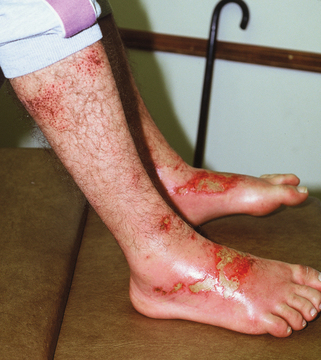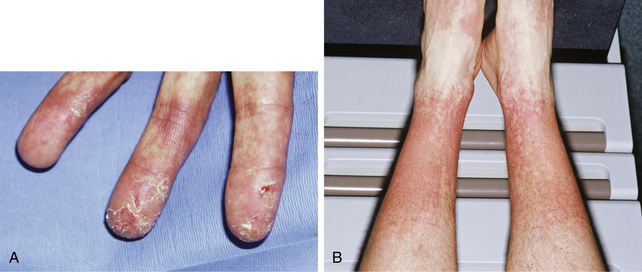Chapter 65 Occupational dermatology
1. What is the most common type of skin disease due to workplace exposures?
Contact dermatitis accounts for >90% of occupational skin disease (OSD) cases. The most common location of job-related contact dermatitis is workers’ hands. It is generally accepted that 80% of the contact dermatitis cases are irritant (Fig. 65-1), while 20% are allergic (Fig. 65-2). Recent studies have challenged those figures, demonstrating that up to 40% of work-related skin diseases were from allergic contact dermatitis (ACD). Pure allergic contact dermatitis in the occupational setting is uncommon because a component of irritant contact dermatitis (ICD) is frequently present. Bureau of Labor and Statistics data show that OSD accounted for 16.5% of all occupational illnesses in 2005. Some have estimated the true number of cases to be 10 to 50 times higher than that due to underreporting and underdiagnosis. The “standard” allergens patch test screens for only approximately 75% of common allergens, so additional specialized testing with industrial chemicals to which the worker is exposed is frequently warranted. Testing should only be done with known materials in accepted concentrations.
Lushniak, BD: Occupational contact dermatitis, Dermatol Ther 17:272–277, 2004.
3. Are there any risk factors for the development of an OSD?
Various investigators have found a personal history of atopic dermatitis to be a significant risk factor. Other preexisting skin diseases with compromised epidermal barriers, such as xerosis or nummular eczema, can predispose a person to contact dermatitis because of enhanced absorption of irritants and allergens through the skin. Poor personal hygiene plays a role in patients who neglect to wash off irritating and sensitizing chemicals, thereby prolonging contact time. However, overwashing is actually the more common problem. The use of harsh soaps and frequent wetting/drying cycles induce chapping and desiccation, which compromises the skin barrier. Environmental factors are also important. If it is hot and humid, workers may perspire, which can solubilize particulate matter, enhancing its penetration into the skin. Sweat can also leach out allergens, such as chromates from leather shoes, inducing an allergic contact dermatitis. Conversely, low temperature and humidity causes chapping of the skin, which can lead to irritant contact dermatitis. Certain jobs also are more likely to be associated with OSD, such as nursing and health care aides.
Stay updated, free articles. Join our Telegram channel

Full access? Get Clinical Tree










